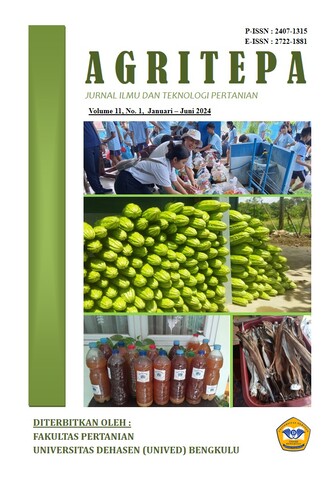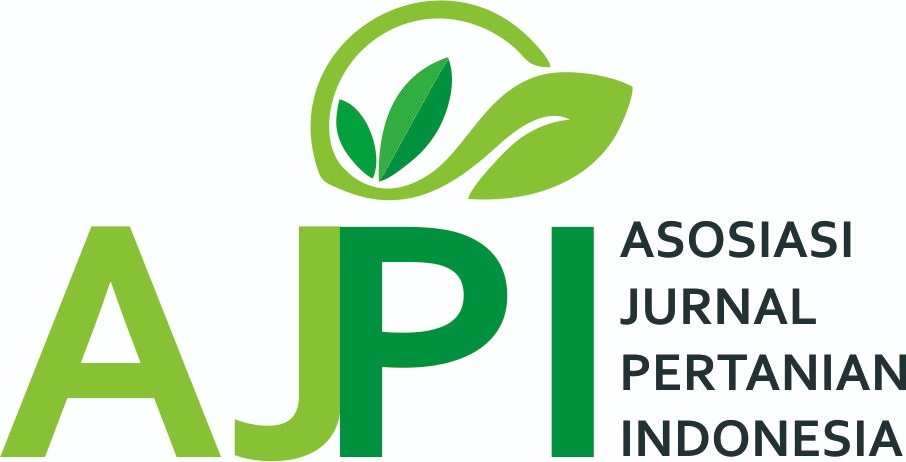Effect of Salt Concentration and Fermentation Time In The Development of Anchovy (Stolephorus Sp) Bekasam as Tempura Raw Material
Abstract
Purpose: This study aimed to analyze the effect of salt concentration and fermentation time on the chemical characteristics and lactic acid bacteria of anchovy bekasam, and the sensory evaluation of anchovy bekasam as a raw material for tempura. Methodology: The tests conducted included water content (thermogravimetry), pH (pH meter), fat content (soxhlet), bacterial count (TPC), and sensory evaluation (hedonic). The study used a Randomized Complete Block Design (RCBD) with two factors: salt concentration (15% and 20%) and fermentation time (4 days and 7 days).Results: The results indicated that both salt concentration and fermentation time significantly affected the water content, pH, and total lactic acid bacteria. The fat content was not significantly affected by the two factors but showed a decrease. Findings: Variations in salt concentration and fermentation time influenced the panelists' sensory preferences for color, aroma, taste, texture, and overall acceptability. The highest overall liking score was achieved by the sample with 15% salt concentration and 7 days of fermentation (K1L2). Novelty: This research provides insight into the optimal conditions for producing anchovy bekasam with desirable chemical and sensory properties, specifically for its use as a raw material for tempura. Originality: The study highlights the impact of different salt concentrations and fermentation times on both the chemical and sensory characteristics of bekasam, offering new information on improving its production process. Conclusions: The sample with 15% salt concentration and 7 days fermentation time yielded the most favorable results in terms of both chemical characteristics and sensory evaluation. Paper Type: Experimental Research Article
Keywords: Bekasam; fish; fermentation; salt; tempura
Downloads
References
Alyani, F., Ma’Ruf, W. F., & Anggo, A. D. (2016). Pengaruh Lama Perebusan Ikan Bandeng
(Chanos Chanos Forsk) Pindang Goreng Terhadap Kandungan Lisin Dan Protein
Terlarut. Jurnal Pengolahan Dan Bioteknologi Hasil Perikanan, 5(1), 88–93.
Arfianty, B. N., Farisi, S., & Ekowati, C. N. (2017). Dinamika Populasi Bakteri dan Total
Asam Pada Fermentasi Bekasam Ikan Patin (Pangasius hypopthalmus). Jurnal Biologi
Eksperimen Dan Keanekaragaman Hayati, 4(2), 43–49.
Aryati, E., & Dharmayanti, A. W. S. (2014). Manfaat Ikan Teri Segar (Stolephorus sp)
Terhadap Pertumbuhan Tulang dan Gigi. ODONTO Dental Journal, 1(2), 52–56.
Bawinto, A. S., Mongi, E. L., & Kaseger, B. E. (2015). Analisis Kadar Air, pH, Organoleptik,
dan Kapang pada Produk Ikan Tuna (Thunnus Sp) Asap, di Kelurahan Girian Bawah,
Kota Bitung, Sulawesi Utara. Media Teknologi Hasil Perikanan, 3(2), 55–65.
https://doi.org/10.35800/mthp.3.2.2015.10355
BPS kota Bandar Lampung. (2020). Produksi Ikan Laut Menurut Jenisnya di Kota Bandar
Lampung, 2020. Https://Bandarlampungkota.bps.go.Id/.
Huda, N. (2012). - Probiotics: An Overview. Handbook of Animal-Based Fermented Food
and Beverage Technology, May 2012, 758–765. https://doi.org/10.1201/b12084-47
Indah, D., Yanti, W., & Dali, F. A. (2014). Karakterisasi Bakteri Asam Laktat Yang Diisolasi
Selama Fermentasi Bakasang. Jurnal Pengolahan Hasil Perikanan Indonesia, 16(2),
–141.
Kalor, J. D., Runggamusi, B. S., & Rumahorbo, B. T. (2022). Analisis Kadar Air, Lemak,
Protein dan Uji Organoleptik Pada Ikan Tuna (Katsuwonus pelamis, L). ACROPORA:
Jurnal Ilmu Kelautan Dan Perikanan Papua, 4(2).
https://doi.org/10.31957/acr.v4i2.1905
Kiwak, P. H., Montolalu, L. A. D. Y., Reo, A. R., Pandey, E. V., Kaseger, B. E., &
Makapedua, D. M. (2018). Pengujian TPC, Kadar Air Dan PH Pada Ikan Kayu
Cakalang (Katsuwonus pelamis L) Yang Disimpan Pada Suhu Ruang. Media Teknologi
Hasil Perikanan, 6(3), 71. https://doi.org/10.35800/mthp.6.3.2018.20652
Kurnianto, M. A., & Munarko, H. (2022). Pengaruh Penambahan Kultur Starter dan
Metabolit Lactobacillus casei Terhadap Mutu Mikrobiologi Sosis Fermentasi Ikan Patin
(Paasius sp). Jurnal Kelautan Dan Perikanan Terapan (JKPT), 5(1), 27–37.
https://doi.org/http://dx.doi.org/10.15578/jkpt.v5i1.10970
Majid, A., Agustini, T. W., & Rianingsih, L. (2014). Pengaruh Perbedaan Konsentrasi Garam
Terhadap Mutu Sensori dan Kandungan Senyawa Volatil Pada Terasi Ikan Teri
(Stolenphorus sp). Jurnal Pengolahan Dan Bioteknologi Hasil Perikanan, 3(2), 17–24.
Marvie, I., Sitanggang, A. B., & Budijanto, S. (2022). Characterization of Insoluble Fiber in
Cassava Peel and Its Hydrolyzate Potential as a Prebiotic for Lactobacillus Plantarum.
–37. https://doi.org/10.5220/0010507300003108
Marvie, I., & Sunarti, T. C. (2021). Pemanfaatan Selulosa Frond Sagu untuk Produksi
Hidrolisat Prebiotik Melalui Hidrolisis Enzimatis. Journal of Science, Technology, and
Virtual Science, 1(3), 155–163.
Mumtianah, O. N., Kusdiyantini, E., & Budiharjo, A. (2014). Isolasi, Karakterisasi Bakteri
Asam Laktat, dan Analisis Proksimat dari Makanan Fermentasi Bekasam Ikan Mujair
(Oreochromis mossambicus Peters). Jurnal Biologi, 3(2), 20–30.
Puspita, D. A., Agustini, T. W., & Purnamayati, L. (2019). Pengaruh Perbedaan Konsentrasi
Garam terhadap Kadar Asam Glutamat Pada Bubuk Bekasam Ikan Lele (Clarias
batracus). Jurnal Teknologi Pangan, 3(1), 110–115.
Putri, D. M., Budiharjo, A., & Kusdiyantini, E. (2014). Isolasi, Karakterisasi Bakteri Asam
Laktat, dan Analissi Proksimat dari Pangan Fermentasi Rusip Ikan Teri (Stolephorus
sp.). Jurnal Biologi, 3(2), 11–19.
Rinto, R., Baehaki, A., & Subarka, H. (2019). Study Of Antioxidant Aktivity, Anticolestrol
And Antihypertence Of Extract Rusip. Jurnal FishtecH, 8(1), 18–27.
https://doi.org/10.36706/fishtech.v8i1.7841
Rinto, R., Herpandi, H., Widiastuti, I., Sudirman, S., & Sari, M. P. (2022). Analisis Bakteri
Asam Laktat dan Senyawa Bioaktif selama Fermentasi Bekasam Ikan Nila
(Oreochromis niloticus). AgriTECH, 42(4), 400. https://doi.org/10.22146/agritech.70500
Waty, K., Purwijantiningsih, E., & Pranata, S. (2019). Kualitas Fermentasi Spontan Wadi
Ikan Patin ( Pangasius Sp .) dengan Variasi Konsentrasi Garam The Quality of
Spontaneous Fermentation of Catfish ’ s Wadi ( Pangasius sp .) with Different
Concentration of Salt. Biota : Jurnal Ilmiah Ilmu-Ilmu Hayati, 4(November 2018), 24–
Widayanti, Ibrahim, R., & Rianingsih, L. (2015). Pengaruh Penambah Berbagai Konsentrasi
Bawang Putih (Allium sativum L.) Terhadap Mutu Bekasam Ikan Nila Merah
(Oreochromis niloticus). Indonesian Journal of Fisheries Science and Technology
(IJFST), 10(2), 119–124.
Copyright (c) 2024 Ririn Margiati, Ilham Marvie, Syahrizal Nasution (Author)

This work is licensed under a Creative Commons Attribution-ShareAlike 4.0 International License.
Author retains the copyright and grants the journal the right of first publication of the work simultaneously licensed under the Creative Commons Attribution-ShareAlike 4.0 License that allows others to share the work with an acknowledgement of the work's authorship and initial publication in this journal













